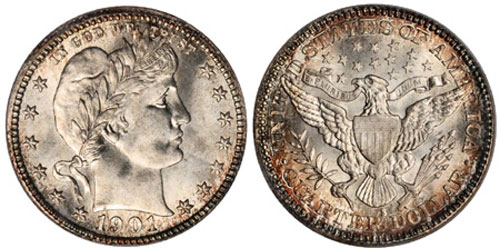Background and History
Many consider the 1901-S Barber Quarter (Buy on eBay) to be the rarest non-gold United States coin of the 20th century. The issue is scarce and desirable at all grade levels, with even barely recognizable survivors commanding prices in the thousands of dollars. Virtually all examples are found in well-circulated condition, an indication that nearly the entire original mintage was immediately released into circulation after production. The few survivors in uncirculated condition generate substantial interest at auction and sell for large sums.

The Barber Quarter series was introduced in 1892 and struck at various mint facilities until 1916. During this period, the dime, quarter, and half dollar all shared the same basic design created by Charles E. Barber. The obverse of all three coins features the head of Liberty wearing a cap adorned with a laurel wreath and a headband carrying the inscription LIBERTY. The image is surrounded by thirteen stars and the motto IN GOD WE TRUST. The reverse design for both the quarter and half dollar features a heraldic eagle with a shield at its chest and its talons grasping an olive branch and bundle of arrows. A ribbon in the eagle’s beak reads E PLURIBUS UNUM and thirteen stars appear in the field above.
There are a number of rarities that stand out when exploring the three series of Barber coinage. The dime series includes the 1894-S dime, which was created under mysterious circumstances with an original mintage believed to be a mere 24 pieces. The quarters include the three low mintage issues of 1896-S, 1901-S, and 1913-S. Finally, the half dollar series features the unusual 1892-O “Micro O” variety. Among these issues, the 1901-S quarter stands apart as the most elusive regular issue which leads to its frequent identification as the “King of Barber Coinage.”
As can be expected with such a rare and prized coin, some counterfeits do exist. Genuine examples of the 1901-S quarter exhibit a number of unique features which makes identification possible for experienced collectors, although certification is still recommended. Only two die pairs were used to strike the full mintage. They are identified by the placement of the date on the obverse (in particular the placement of the 1’s above the denticles) and the placement of the mintmark on the reverse. The style of the mintmark is also important, as added mintmarks are always from a slightly different punch than the one which was actually used.
Coin Mintage
The 1901-S Barber Quarter had a total mintage of 72,664 pieces struck for circulation at the San Francisco Mint. This represented the lowest mintage for the series at the time, however it would later be undercut by the 1913-S which had a mintage of 40,000 pieces. Nonetheless, extensive circulation took a heavier toll on the 1901-S, making it the rarer of the two issues with perhaps 1,500 to 2,000 examples surviving across all grades. The majority of these are well-circulated, often barely recognizable, while only a distinct minority have managed to survive in uncirculated condition.
Compared to other quarters of the early 20th century, the mintage of the 1901-S quarter is extremely low. Virtually all other issues of this period had a mintage at least ten times greater. The output from the San Francisco Mint was more than 1.5 million pieces in both 1900 and 1902, the years immediately before and after the key date rarity. The reason for the low production in 1901 is unknown, but many have speculated that the San Francisco Mint may have had an adequate supply of freshly minted quarters from other years in storage and planned to release these prior to striking large quantities of additional quarters.
The small number of newly minted quarters would soon end up in circulation, and it would take another few decades before the issue attracted the attention of collectors. By this time, much of the original mintage had been lost or survived only in well-worn or damaged condition.
Finest Known and Values
The absolute finest known 1901-S Barber Quarter is a single piece which has been graded PCGS MS-68+. This coin had previously been certified as PCGS MS-68 and changed hands a few times while carrying this grade. It achieved the record price for the issue when sold within Superior’s Father Flanagan’s Boys Home Sale in 1990 for $550,000. Decades later it was sold at a Heritage auction in March 2010 for $327,750. Shortly after the auction this coin was regraded with the plus designation and served as a featured coin for PCGS’s announcement of Secure Plus grading. In May 2010, it was announced that the coin had been sold privately for an undisclosed price.
Other high-grade examples include three pieces graded by PCGS as MS-67, five pieces graded MS-66, and eight gems graded MS-65. The finest pieces graded by NGC include just two examples at MS-67, followed by one example at MS-66, and three at MS-65. These numbers may include a few resubmissions, which means the actual rarity of the pieces could be even greater than the numbers imply.
Besides the finest known specimen, multiple examples of the 1901-S Barber Quarter have achieved six figure prices. An extremely strong price was realized in 2014 for an example graded PCGS MS-67 with CAC verification, which sold for $258,500. An example graded NGC MS-67 made less of an impression with buyers and sold for $105,750 in 2012. At the AU grade level, prices tend to range from $20,000 to $30,000 depending on quality. The lowest grades, often having multiple problems such as cleaning and various other forms of damage, usually sell for a couple of thousand dollars each.

